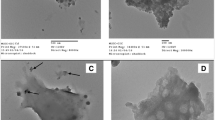Abstract
Recently a modified glass ionomer cement (GIC) with enhanced bioactivity due to the incorporation of wollastonite or mineral trioxide aggregate (MTA) has been reported. The aim of this study was to evaluate the cytotoxic effect of the modified GIC on odontoblast-like cells. The cytotoxicity of a conventional GIC, wollastonite modified GIC (W-mGIC), MTA modified GIC (M-mGIC) and MTA cement has been evaluated using cement extracts, a culture media modified by the cement. Ion concentration and pH of each material in the culture media were measured and correlated to the results of the cytotoxicity study. Among the four groups, conventional GIC showed the most cytotoxicity effect, followed by W-mGIC and M-mGIC. MTA showed the least toxic effect. GIC showed the lowest pH (6.36) while MTA showed the highest (8.62). In terms of ion concentration, MTA showed the largest Ca2+ concentration (467.3 mg/L) while GIC showed the highest concentration of Si4+ (19.9 mg/L), Al3+ (7.2 mg/L) and Sr2+ (100.3 mg/L). Concentration of F− was under the detection limit (0.02 mg/L) for all samples. However the concentrations of these ions are considered too low to be toxic. Our study showed that the cytotoxicity of conventional GIC can be moderated by incorporating calcium silicate based ceramics. The modified GIC might be promising as novel dental restorative cements.


Similar content being viewed by others
References
Wilson AD, Kent BE. Glass-ionomer cement, a new translucent dental filling material. J Appl Chem Biotechnol. 1971;21(11):313.
Nicholson JW, Czarnecka B. Review paper: role of aluminum in glass-ionomer dental cements and its biological effects. J Biomater Appl. 2009;24(4):293–308.
Toledano M, Osorio R. New advanced materials for high performance at the resin-dentine interface. Front Oral Biol. 2015;17:39–48.
Kamitakahara M, Kawashita M, Kokubo T, Nakamura T. Effect of polyacrylic acid on the apatite formation of a bioactive ceramic in a simulated body fluid: fundamental examination of the possibility of obtaining bioactive glass-ionomer cements for orthopaedic use. Biomaterials. 2001;22(23):3191–6.
Jefferies SR, Fuller AE, Boston DW. Preliminary evidence that bioactive cements occlude artificial marginal gaps. J Esthet Restor Dent. 2015;27(3):155–66.
Chen S, Cai Y, Engqvist H, Xia W. Enhanced bioactivity of glass ionomer cement by incorporating calcium silicates. Biomatter. 2016;. doi:10.1080/21592535.2015.1123842.
Meryon SD, Stephens PG, Browne RM. A comparison of the in vitro cytotoxicity of two glass-ionomer cements. J Dent Res. 1983;62(6):769–73.
Ribeiro DA, Marques ME, Salvadori DM. Genotoxicity and cytotoxicity of glass ionomer cements on Chinese hamster ovary (CHO) cells. J Mater Sci Mater Med. 2006;17(6):495–500.
Eid AA, Gosier JL, Primus CM, Hammond BD, Susin LF, Pashley DH, et al. In vitro biocompatibility and oxidative stress profiles of different hydraulic calcium silicate cements. J Endod. 2014;40(2):255–60.
Gomes-Cornelio AL, Rodrigues EM, Salles LP, Mestieri LB, Faria G, Guerreiro-Tanomaru JM, et al. Bioactivity of MTA plus, biodentine and experimental calcium silicate-based cements in human osteoblast-like cells. Int Endod J. 2016;. doi:10.1111/iej.12589.
Sauro S, Osorio R, Watson TF, Toledano M. Influence of phosphoproteins’ biomimetic analogs on remineralization of mineral-depleted resin-dentin interfaces created with ion-releasing resin-based systems. Dent Mater. 2015;31(7):759–77.
Bortoluzzi EA, Niu LN, Palani CD, El-Awady AR, Hammond BD, Pei DD, et al. Cytotoxicity and osteogenic potential of silicate calcium cements as potential protective materials for pulpal revascularization. Dent Mater. 2015;31(12):1510–22.
Mestieri LB, Gomes-Cornélio AL, Rodrigues EM, Salles LP, Bosso-Martelo R, Guerreiro-Tanomaru JM, Tanomaru-Filho M. Biocompatibility and bioactivity of calcium silicate-based endodontic sealers in human dental pulp cells. J Appl Oral Sci. 2015;23(5):467–71.
Biological evaluation of medical devices—Part 11: tests for systemic toxicity. International Organization for Standardization. BS EN ISO 10993-11:2006.
Kanjevac T, Milovanovic M, Milosevic-Djordjevic O, Tesic Z, Ivanovic M, Lukic A. Cytotoxicity of glass ionomer cement on human exfoliated deciduous teeth stem cells correlates with released fluoride, strontium and aluminum ion concentrations. Arch Biol Sci. 2015;67(2):619–30.
Bouillaguet S. Biological risks of resin-based materials to the dentin-pulp complex. Crit Rev Oral Biol Med. 2004;15(1):47–60.
Lessa FC, Aranha AM, Hebling J, Costa CA. Cytotoxic effects of white-MTA and MTA-bio cements on odontoblast-like cells (MDPC-23). Braz Dent J. 2010;21(1):24–31.
de Souza Costa CA. Hebling J, Garcia-Godoy F, Hanks CT. In vitro cytotoxicity of five glass-ionomer cements. Biomaterials. 2003;24(21):3853–8.
Torabinejad M, Hong CU. Pitt Ford TR, Kettering JD. Cytotoxicity of four root end filling materials. J Endod. 1995;21(10):489–92.
Lan WC, Lan WH, Chan CP, Hsieh CC, Chang MC, Jeng JH. The effects of extracellular citric acid acidosis on the viability, cellular adhesion capacity and protein synthesis of cultured human gingival fibroblasts. Aust Dent J. 1999;44(2):123–30.
Keenan TJ, Placek LM, McGinnity TL, Towler MR, Hall MM, Wren AW. Relating ion release and pH to in vitro cell viability for gallium-inclusive bioactive glasses. J Mater Sci. 2015;51(2):1107–20.
Chang YC, Chou MY. Cytotoxicity of fluoride on human pulp cell cultures in vitro. Oral Surg Oral Med Oral Pathol Oral Radiol Endod. 2001;91:230–4.
Stanislawski L, Daniau X, Lauti A, Goldberg M. Factors responsible for pulp cell cytotoxicity induced by resin-modified glass ionomer cements. J Biomed Mater Res. 1999;48(3):277–88.
Lan WH, Lan WC, Wang TM, Lee YL, Tseng WY, Lin CP, Chang MC, Jeng JH. Cytotoxicity of conventional and modified glass ionomer cements. Oper Dent. 2003;28(3):251–9.
Acknowledgments
We gratefully acknowledge support from VR (Swedish Research Council (2013-5419 and 2011-3399) and CSC (China Scholarship Council). GM thanks Marie Curie Actions FP7-PEOPLE-2011-COFUND (GROWTH 291795) for funding via the VINNOVA program Mobility for Growth and Lars Hiertas Minne Foundation (Project No. FO2014-0334).
Author information
Authors and Affiliations
Corresponding author
Additional information
Song Chen and Gemma Mestres have contributed equally to this work.
Rights and permissions
About this article
Cite this article
Chen, S., Mestres, G., Lan, W. et al. Cytotoxicity of modified glass ionomer cement on odontoblast cells. J Mater Sci: Mater Med 27, 116 (2016). https://doi.org/10.1007/s10856-016-5729-y
Received:
Accepted:
Published:
DOI: https://doi.org/10.1007/s10856-016-5729-y




